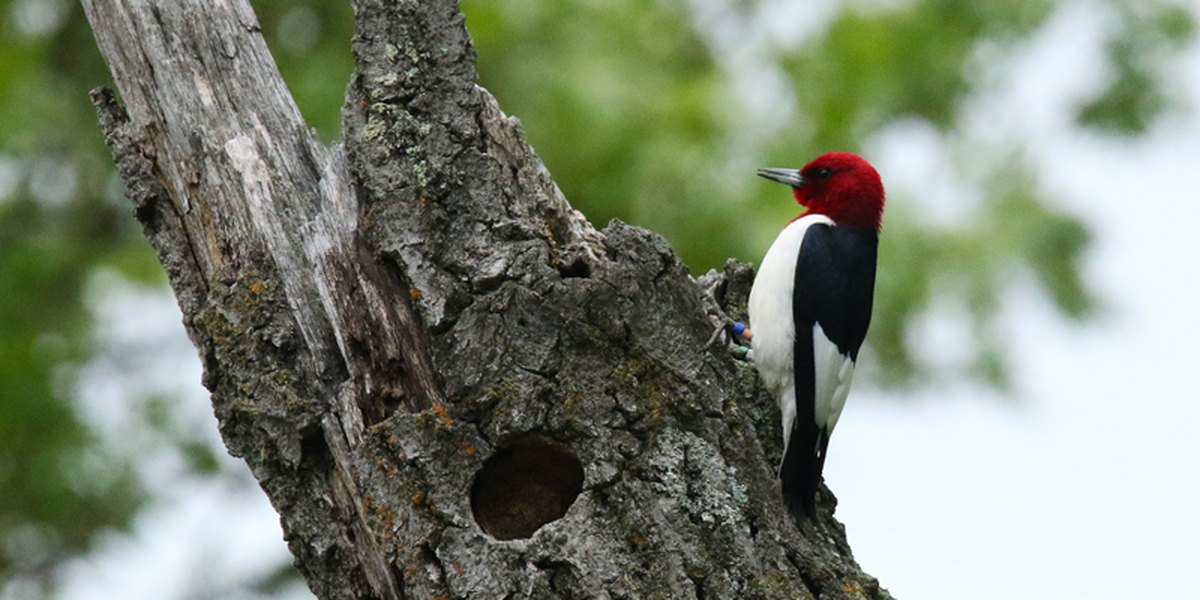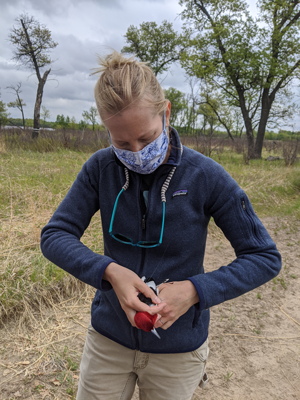
From performing impressive aerial acrobatics to stashing cicadas under tree bark, red-headed woodpeckers are curious creatures. Both the birds, along with oak savannas they inhabit, were once very common across the midwest. That’s no longer the case, but both are thriving at Cedar Creek Ecosystem Science Reserve, which boasts the largest known population of breeding red-headed woodpecker pairs in Minnesota. The birds are savanna specialists and Cedar Creek is home to one of the largest remnants of intact oak savanna in Minnesota.
Teasing out what their preferred habitat looks like and what drives their success are questions that Dr. Elena West, a postdoctoral researcher, hopes to answer. She leads a dynamic team made up of volunteers, land managers, and community scientists from a range of disciplines. We recently caught up with her to learn more about her ongoing work.

Q: What does your research focus on?
A: I am a wildlife ecologist and conservation scientist, which means that I use data and models to figure out how to more effectively conserve and manage wildlife and their ecosystems. My research to date has largely been focused on identifying the aspects of oak savanna habitat that drive red-headed woodpecker nest success, population growth, and migration patterns. We attach small (less than 2.5 grams) tracking devices to birds, which helps us understand how they use habitat. Red-headed woodpeckers are facultative migrants, meaning in some years they migrate and others they don’t. We still don’t have very good information on where they spend the winter when they do migrate, and this has implications for conservation of their wintering grounds. I’ve also been studying their behavior and movement ecology during the breeding season and trying to untangle questions about the processes that drive nest success. Cavity nesters are hard to study—we need specialized equipment to peek inside to see what’s going on.
Q: What have you learned about the tree cavities?
A: It turns out that there’s a lot of competition for these cavities, including bats, squirrels, tree frogs, mice and other birds. We don’t have a very good understanding of the community of animals that depend on these cavities and how they use them throughout the year, which may subsequently impact red-headed woodpecker nest success through competition and predation pressure. With the help of some volunteers, we installed a series of trail cameras near red-headed woodpecker cavities over the last two field seasons to capture the behaviors and interactions of the community of animals that use these cavities. We’re launching the project through Zooniverse, an online platform where volunteers come together to assist researchers like me in classifying images or videos to answer scientific questions. It’s an exciting new development on this project and I think we’re going to learn lots of valuable new information while hopefully also sparking curiosity about a part of the natural world (high up in the trees!) that most of us typically don’t have access to.
Q: How long have you been studying the woodpeckers at Cedar Creek? What got you interested in doing so?
I’ve been studying red-headed woodpeckers at Cedar Creek for over three years. Cedar Creek has the largest breeding population of this species in the entire state (about 80-100 pairs breed there each year) and despite their being pretty common historically, there are still many aspects of their life history that are unclear. Their drastic decline throughout their Midwest range has spurred renewed interest in their ecology and behavior, particularly as it relates to habitat needs, and that really spurred my interest. Red-headed woodpeckers are a savanna specialist and Cedar Creek boasts one of the largest remnants of intact oak savanna in Minnesota, along with a prescribed fire program that’s been running since the 1960’s. Fire plays an important role in savanna ecosystems, and it seemed like there was probably a connection between these factors and the presence of red-headed woodpeckers. The chance to untangle some of that to help inform habitat restoration efforts for this species and other savanna specialists was a big draw.
Q: Who do you work with?
A: I’m currently a postdoctoral researcher with the Minnesota Cooperative Fish and Wildlife Research Unit and Department of Fisheries, Wildlife, and Conservation Biology. I conduct much of my field work at Cedar Creek, and through that I’ve been really lucky to be a part of the community of staff and researchers there. I was also lucky to start my research with the help and support of the staff and researchers at Cedar Creek and volunteers from the Audubon Chapter of Minneapolis (ACM) who had worked for many years to monitor nests. It’s been really rewarding to work on a project with many different people at the table, with a collective goal to improve our understanding of this species and its habitat needs and to bridge the gap between science and management. Science is increasingly an interdisciplinary endeavor and in my experience, answering important questions isn’t something I can do on an island. My science is better because I work with researchers from other disciplines, volunteers, land managers, and community scientists.
Q: What appeals to you about these particular birds?
Woodpeckers, as a group, are fascinating—they’re bold and boisterous in defending their nest cavities and attracting mates and, at the same time, pretty secretive in terms of their nesting and roosting habits inside cavities. And there’s still a great deal we don’t understand about the role of drumming as a form of communication.
Red-headed woodpeckers are pretty unique in their own right. They’re probably the most omnivorous woodpecker in North America and they’re also one of just a few species of woodpecker that captures most of their animal prey by flycatching (flying out from a perch to grab insects). It’s pretty special to see some of their aerial acrobatics. And they’re the only woodpecker species known to store food under wood or bark. I’ve seen birds grab cicadas out of the air and stuff them under a piece of tree bark while they’re still alive. They’re birds with a lot of gusto and that makes studying them even more interesting. It’s meaningful to be able to study them in a place where they appear to be doing relatively well, and I hope that what we learn at Cedar Creek can be applied to other areas in Minnesota and the Midwest.